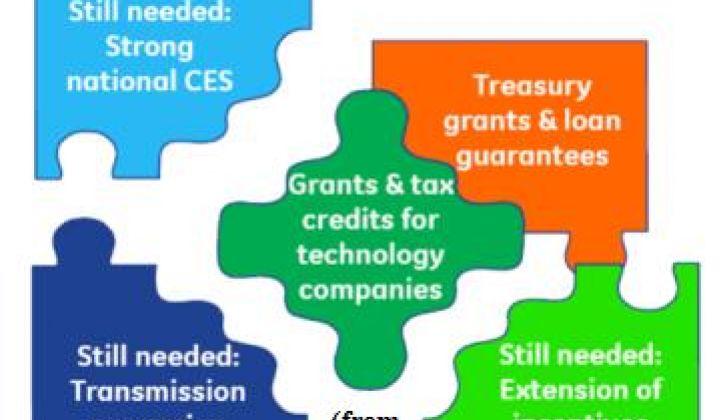The struggle on the part of renewable energy advocates for a federal Renewable Electricity Standard (RES) hit the wall in the 2010 election.
Such a standard would create needed long-term demand certainty for renewables by requiring regulated U.S. utilities to obtain a specified portion of their power from renewable sources over the coming decade. But the economy and the rise of fossil fuel-funded conservatives now make that renewables standard a low priority in Washington.
Pessimists foresee little hope for renewable energy. Optimists insist its logic remains undeniable. Realists follow the money. Following the money will lead, D.C. insiders say, to a Clean Energy Standard (CES).
“The election was a mixed message,” Jonathan Weisgall, Vice President of Legislative and Regulatory Affairs for MidAmerican Energy Holdings, said, though the only mandate on energy was to not do cap-and-trade. “If you’re John Boehner, you’re going to ask, ‘Is this going to create jobs? Is this going to get the economy going?’”
Weisgall asked himself, “What will get Republican support?” and saw strong backing for nuclear power and for so-called 'clean' coal. “And new nuclear is at least a decade away,” he said that he realized, not to mention the fact that carbon capture and sequestration “is AT LEAST a decade away.” AT this point, it occurred to Weisgall that Democrats “might be able to get some votes without compromising,” he said, adding, “If you’re an environmentalist, I don’t think you give up all that much.”
Applying this strategy, Weisgall cautioned, necessitates raising the percentage of clean energy required by the standard. “If you raise it to 25 or 30 or 35 -- because given the fact that nuclear is twenty percent of our electricity base you would have to kick up that standard quite a bit -- that might get some Republican votes. ‘All of the above’ is a Republican mantra.”
Pushing for a standard instead of new incentives has one important advantage, Weisgall pointed out. “The beauty of a Renewable Energy Standard or a Clean Energy Standard is that it doesn’t score. Money does not come out of the federal budget.”
The devil is certainly, Weisgall insisted repeatedly, in the details. But, he believes, “if you’re the Republicans, your main goal is stopping the EPA from regulating greenhouse gas emissions under the Clean Air Act,” he said. “And you’ve got a president who has as good as said, ‘This isn’t my first choice, either.’ That could smack of a deal. I give you a two-year timeout. You claim victory there. You guys have two years to come up with something that makes sense and really gets some incentives in there for renewables.”
Weisgall was unequivocal about not permanently dealing away the EPA’s emissions-enforcement powers. While he sees the possibility of Democrats and environmentalists making a deal on a two-year moratorium, EPA’s ultimate power -- as defined by the Supreme Court -- is too important to forego. “I see a timeout. I don’t see more than a timeout.”
Earlier this year, Senator Lindsey Graham (R-SC) worked with Democrats to shape a CES similar to what Weisgall outlined instead of the Bingaman (D-NM)/ Brownback (R-KS) RES that Graham said in an email statement “short-changes nuclear power, a safe reliable form of clean energy” and “also does not have an expansive view of biomass opportunities.” Graham added, “I have an ‘all of the above’ approach” and said his CES “will reinvigorate our nation’s nuclear energy sector, create jobs, make us more energy independent, and produce a cleaner environment than other standards.”
Graham worked last summer to shape an ultimately unsuccessful proposal that required utilities to obtain thirteen percent of their power from 'clean' sources by 2013, twenty percent by 2020 and five more percent every five years through 2050.
Whether the Republican shift to the right will allow Senator Graham to continue working for a CES is not clear. Political ambiguity now permeates the CES discussion from every political angle.
GE, which has major financial interests both in renewables and traditional energy generation, advocated earlier this year for a CES. Yet it was unwilling to call for anything more specific than “a federal standard” when contacted for comment during the writing of this piece.
The American Wind Energy Association, usually the leading voice in the renewables sector, has shown no inclination to give up its long campaign for an RES. After the election, it held an event to reiterate its commitment to the RES and insist the potential for bipartisan support remains.
In the same week, Richard Glick, the Vice President for Government Affairs with Iberdrola Renewable Energies, USA -- a leading renewables developer -- made a completely different observation.
“The change in the House leadership has pretty much signaled the death knell for the renewables standard,” Glick told a Chadbourne and Parke webinar audience. “We need to start thinking more broadly in the renewable electricity industry about working with some other technologies such as nuclear and clean coal on a Clean Energy Standard that might be beneficial to all of these technologies. There seems to be enough support for that among Republicans in the Senate and the House that if there is some sort of legislation on energy that’s moving forward in the next Congress,” Glick said, “we have a decent shot at getting a Clean Energy Standard.”
“If you add these other technologies, I think you’re going to have to increase the numbers that we’ve been taking about under the RES,” Glick added, referring to Senator Graham’s proposal. “I think you need something in the 25-to-30-percent range.”



